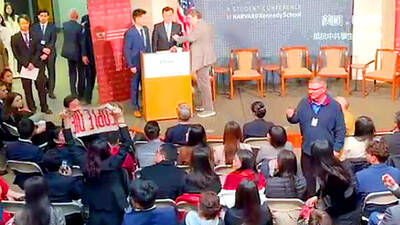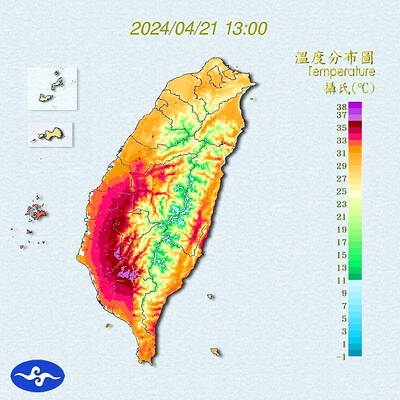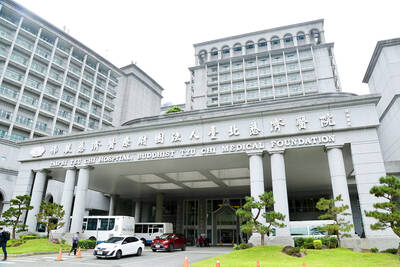The Chinese Nationalist Party (KMT) headquarters yesterday shrugged off proposals by two candidates in the party’s May chairperson election to revise the 3 percent signature threshold for hopefuls, saying that the ideas would not be deliberated until the party’s national congress in August.
According to statistics compiled by the KMT, the party had about 890,000 members as of Friday last week, of whom 230,000 had voting rights in the May 20 election.
Estimates say that the number would increase to 300,000 before March 31, the deadline by which candidates have to obtain signatures from at least 3 percent of all eligible party members.
That means each hopeful has to obtain about 9,000 signatures to validate their bid.
KMT Vice Chairman Hau Lung-bin (郝龍斌) and former vice president Wu Den-yih (吳敦義), both of whom have thrown their hats into the ring, have called for revision or removal of the signature requirement.
There are already far too many requirements to qualify as a candidate, such as experience as a member of the KMT’s Central Committee and a hefty security deposit, Hau said on Monday, adding that the party leadership should revoke unnecessary rules such as the signature threshold.
KMT Culture and Communications Committee deputy director Hu Wen-chi (胡文琦) yesterday said that KMT headquarters respects each candidate’s opinion about the signature threshold, but they should nevertheless “follow the rules of the game.”
“According to the party’s regulations for chairperson elections, every candidate must meet the 3 percent signature threshold,” Hu said, adding that KMT Chairwoman Hung Hsiu-chu (洪秀柱) is also subject to the requirement.
If any hopeful sees a need for revision of the requirement, KMT headquarters can consider the proposal at the party’s next national congress, scheduled for Aug. 20, Hu said.
However, even if a change is made, it would not take effect until after the election on May 20, Hu said, adding that the election would have to adhere to the current rules.
Hu dismissed Hau’s concerns that some candidates might collect signatures from party members who have already signed for another to sabotage a rival’s bid.
Hu said that the party is discussing adjustments to the signature collection procedure to eliminate the effectiveness of such tactics.

A group of Taiwanese-American and Tibetan-American students at Harvard University on Saturday disrupted Chinese Ambassador to the US Xie Feng’s (謝鋒) speech at the school, accusing him of being responsible for numerous human rights violations. Four students — two Taiwanese Americans and two from Tibet — held up banners inside a conference hall where Xie was delivering a speech at the opening ceremony of the Harvard Kennedy School China Conference 2024. In a video clip provided by the Coalition of Students Resisting the CCP (Chinese Communist Party), Taiwanese-American Cosette Wu (吳亭樺) and Tibetan-American Tsering Yangchen are seen holding banners that together read:

UNAWARE: Many people sit for long hours every day and eat unhealthy foods, putting them at greater risk of developing one of the ‘three highs,’ an expert said More than 30 percent of adults aged 40 or older who underwent a government-funded health exam were unaware they had at least one of the “three highs” — high blood pressure, high blood lipids or high blood sugar, the Health Promotion Administration (HPA) said yesterday. Among adults aged 40 or older who said they did not have any of the “three highs” before taking the health exam, more than 30 percent were found to have at least one of them, Adult Preventive Health Examination Service data from 2022 showed. People with long-term medical conditions such as hypertension or diabetes usually do not

Heat advisories were in effect for nine administrative regions yesterday afternoon as warm southwesterly winds pushed temperatures above 38°C in parts of southern Taiwan, the Central Weather Administration (CWA) said. As of 3:30pm yesterday, Tainan’s Yujing District (玉井) had recorded the day’s highest temperature of 39.7°C, though the measurement will not be included in Taiwan’s official heat records since Yujing is an automatic rather than manually operated weather station, the CWA said. Highs recorded in other areas were 38.7°C in Kaohsiung’s Neimen District (內門), 38.2°C in Chiayi City and 38.1°C in Pingtung’s Sandimen Township (三地門), CWA data showed. The spell of scorching

POLICE INVESTIGATING: A man said he quit his job as a nurse at Taipei Tzu Chi Hospital as he had been ‘disgusted’ by the behavior of his colleagues A man yesterday morning wrote online that he had witnessed nurses taking photographs and touching anesthetized patients inappropriately in Taipei Tzu Chi Hospital’s operating theaters. The man surnamed Huang (黃) wrote on the Professional Technology Temple bulletin board that during his six-month stint as a nurse at the hospital, he had seen nurses taking pictures of patients, including of their private parts, after they were anesthetized. Some nurses had also touched patients inappropriately and children were among those photographed, he said. Huang said this “disgusted” him “so much” that “he felt the need to reveal these unethical acts in the operating theater